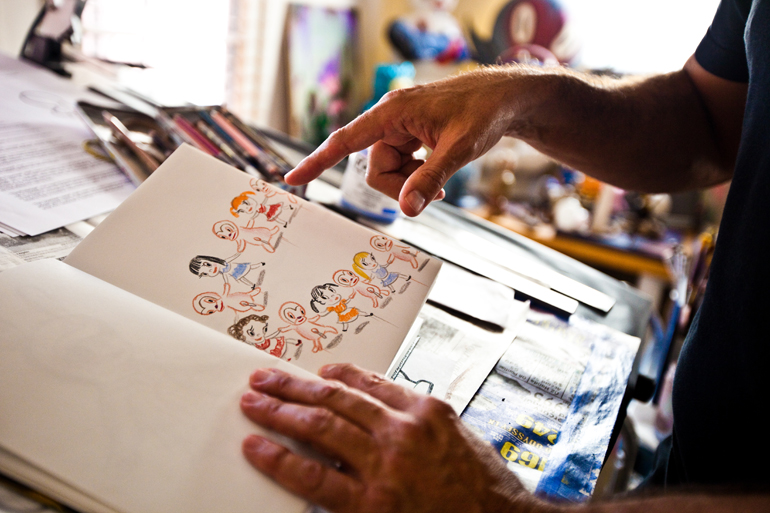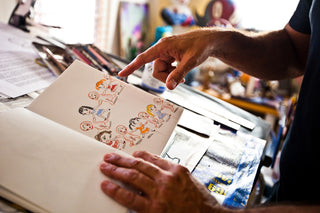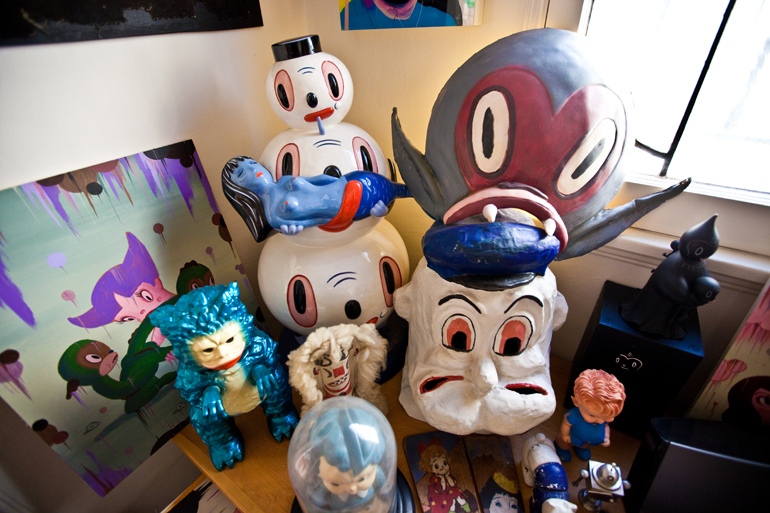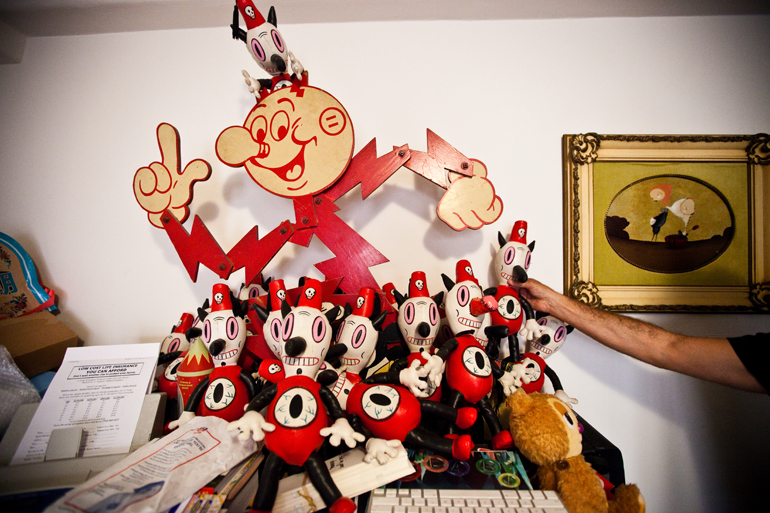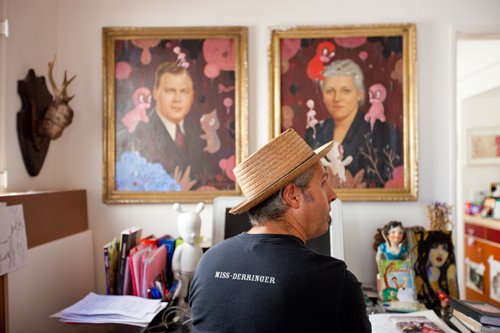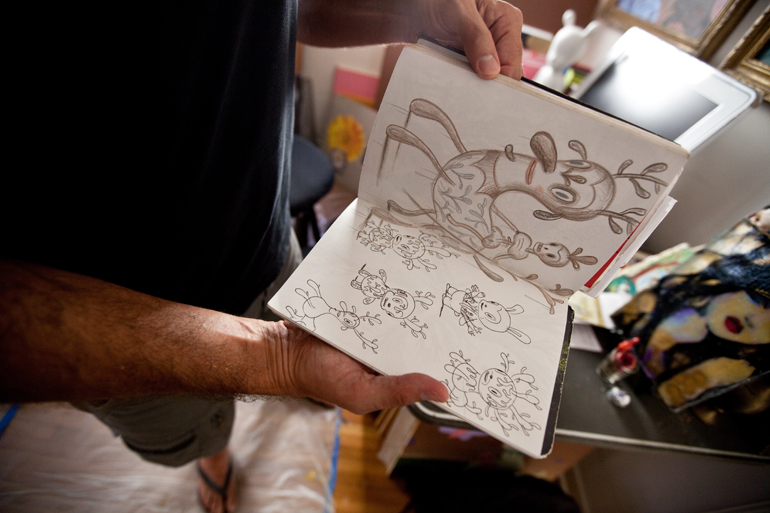Words: John Hall
Photos: Bobby Hundreds
Can you tell us about the show you curated for the Jonathan LeVine Gallery?
I curated a group show at the Jonathan LeVine Gallery called “True Self,” back in October, which originally was to be my solo show. I needed time to regroup after my big dual exhibition and art performance in Los Angeles in May entitled “La Noche de la Fusion.” You could say I’d shot my giant creative wad and I needed time to produce important work that I felt New York deserved. So I asked Jonathan if I could curate an exhibition where I got to expand on my theme of “La Noche,” which was the discovery and acceptance of one’s true self. So I invited a tight group of artists, some being my friends like Mark Ryden, the Clayton Brothers, Eric White, James Jean, including some young artists and new artists who never showed at the Levine Gallery, including one ex-intern. I wanted to mix up the group with some international artists and photographers, inviting each to create a representation of their “true self,” not a self-portrait but an emotional conceptional iconic portrait. I was happy how it turned out. I enjoy the process of curating.
How did you enjoy being an illustrator?
It has been a decade since I was a full-time illustrator. I made a decision to concentrate on being a full-time painter. I wanted to see what I could create if I removed any restraints from my work except my imagination. The goal of a good illustrator is to be a visual problem-solver with one’s own artistic voice. I was actually real proud of working in the editorial world when I was an illustrator. But as a commercial artist, one works within the boundaries of the publication and context of the story. Even though I did have a lot of freedom when I worked with publications like Time magazine, Rolling Stone, The New Yorker, I did have to stay within the boundaries of what was appropriate for the magazine. There isn’t much difference with this than an artist working with a sneaker company. They still have to stay within the boundaries of what is appropriate for the company. Although I haven’t done regular editiorial work in years, I just took on a fiction piece for The New Yorker. I found it challenging to create a visual image based another writer’s universe, since it was the first time in a long time I had to draw a dude in my art; because all my paintings have girls and little surreal creatures. I had to rethink things like, “Huh? How do I even want to do that?†Normally I would just give them a pencil sketch, but I couldn’t do that either. I had to work it through as a rough painting, and then just send it to The New Yorker for approval.
You coined the term “pervasive art†right?
Yes, I created the term “pervasive art” when I found a void in the way people would discuss recent art movements. I didn’t feel “lowbrow” or “pop surrealism” was an appropriate term. Those terms may try to describe the content of the art, but I just felt the content alone in the art was not the reason this art was so special. I looked at all the media. All the new media. Everything that’s going on. There’s a proliferation of new media and how artists and non-artists alike use it, bombarding us from everywhere. It’s no longer just the normal media like magazines, TV, radio, film; it’s the internet, texting, iPhones, Twitter, etc.
I went to Russia for an exhibition, live painting, and lectures, and everyone seems to know what’s happening here in LA. It’s amazing. There’s so much going on, and there are so many ways for us to communicate and create art and images. Maybe almost too much. Trying to name an art movement just because everybody uses pop culture or surreal images, to me, is not interesting. I feel that’s 20th-century thinking, labeling art movements in a way that’s too limiting.
For better or worse, much of the art that new artists are creating uses pop culture as the language, because that is the language we were raised with. We grew up with TV in our face. I was a latch key kid. And now, media culture has expanded outside of our homes to in our pockets. In fact, TV as we know it is dead. At least, how I grew up with it. Everyone has a website, and everyone has a blog, everyone tweets about their latest itch. Everyone is communicating, if they have something to say or not. Down the street, everyone is texting, talking to little devices. I have a cell phone in my right pocket, a digi camera in my left, an iPod touch in my back pocket and a real retro sketchbook in my hand.
It’s the excitement of it all. We need to create from all this newness. The goal should be to use all this new technology to understand our basic “human condition.” Also, what comes into play is the appropriate way for us to work or not work with corporate sponsors. Not too many years ago, if an artist put work on a t-shirt, the fine art community would say the artist was selling out. But now you can see Yoshitomo Nara and Marcel Dzama shirts all around. I feel as long as you stay true to your own message and you have your own visual point of view, you can put your art on anything. And so, if you put it on a t-shirt and you’re not selling out your integrity of the image you’re just selling it’s still your image it’s still your art.
It’s interesting because a lot of people do that now. Obviously with Kaws with vinyl figures, and the list goes on and on. But I think you do it on another scale entirely it seems like with the TV show, and Cranium. I think your art is pervasive in pop culture.
For me, I didn’t have a problem working with big corporations. But everything is kind of experimenting. Like, when I worked at Cranium, it was these two dudes from Microsoft that wanted to promote the ultimate game. I was still doing mainly commercial art but they were still scared to death to work with me. Because they saw the work I did in magazines and it freaked them out. They accepted me when they saw a campaign I did for Mercedes Benz on child safety. It was still very raw, the way I painted. I was doing a lot of work for ‘beach culture,’ and Raygun magazine and things that were just…people starting calling it more ‘art brut’ which is a term based on artists from the ‘30s and ‘40s. But when they saw the work can kinda sweet too, then they were happy using me, then we had a nice ten-year run, until they just sold to Hasbro.
With Disney at the time, for me anyways, for me to even do the TV show [Teacher’s Pet] I already did two pilots for them. I created these ideas, but back then, you had to sell what you had to the company. Not afraid of working with corporations and I was able to really good writers and a really good director my friend director is an amazingly talented asshole (laughs). But he’s really good and we’re able to put together a show that wasn’t necessarily ready for its time. Because that was the thing, its like, we had this weird Saturday morning show that was more of a family show with a little it wasn’t, like what they were normally used too. Critically it went well but having them really support us with the right time slot…not so much. It gets big.
It’s interesting because a lot of people do that now. Obviously with Kaws with vinyl figures, and the list goes on and on. But I think you do it on another scale entirely it seems like with the TV show, and Cranium. I think your art is pervasive in pop culture.
I love the challenge of working in many different mediums. I love the experimentation. Back when I was an illustrator, I loved the challenge of working with corporations, keeping the integrity of my work and still solving their “visual problem.” When I started with Cranium, it was only these two dudes from Microsoft who wanted to create the ultimate game. Even though I was doing mainly commercial art at that time, they were still scared to death to work with me because my work always had an edge to it. I always liked to take risks and push the envelope. They accepted me when they saw a campaign I did for Mercedes-Benz on child safety. The art was still very raw. Some described it then as “art brut.” But in the Mercedes ad, there was a playfulness that they liked. I was doing a lot of raw work for Beach Culture and Raygun magazine that my friend Marvin Jarrett, who now publishes Nylon, produced. We had a nice ten-year run with Cranium, until they sold to Hasbro.
Creating and producing an animated television show for Disney was a different type of challenge. I created the idea for Teacher’s Pet but collaborated with an amazing talented writing couple Bill and Cheri Steinkellner on the series, and a really talented director, Tim Bjorklund. We all made a good team. We wanted the show to look like my paintings and illustrations. All the backgrounds were hand-painted on canvas. I lucked out and had Seonna Hong as my background artist, who went on to be the first American artist to show at Murakami’s gallery in Tokyo. Disney execs were pretty supportive and hands-off with the look until we did our feature film version of the series. But even still, the battles were minor. We got great critical acclaim and I have many Emmys on my mantel for the show. But still we came out at a funky time when ABC and Disney Channel were battling for programming. Even before I got the green light on Teacher’s Pet, I created two different pilots for Nickelodeon of the same idea that never became a series. And I still love that idea. I was never afraid to work with corporations, as long as I could maintain the integrity of my work. When you are working on Network TV, beyond the Disney execs, you also had Disney attorneys, and also an official educator looking at content. But I had such a good team that knew how to keep story and humor first.
Its gets political at that point.
It gets beyond political working with a big network and millions of dollars. Disney is a big company and it generally takes turns and “new ideas” like a giant ocean liner. And a Gary Baseman TV series at that time was a sharp turn.
How did it come about that you ended up studying Communications, and then getting into illustration, and then deciding to become an independent fine artist? And what prompted those transitions?
It’s pretty much “dumb luck,” rather than good or bad luck. Opportunities open up or you make them and you take them or you try your best. I was lucky that my friends Mark Ryden and R. Kenton Nelson introduced me to the Mendenhall Gallery, where they were showing, and where I had my first big solo show. It was an exciting time to see the Clayton Brothers, Eric White, and Joe Sorren move into exhibition work.
I was talking to Greg “Craola” Simkins not too long ago, and I loved hearing stories about where he grew up and how he was involved with his street crew, and how he moved on to painting. Greg is so talented, the nicest guy in the world, and I have one of his paintings in my office. Everyone finds their own way how they create and why they do what they do.
I went to UCLA. I stayed local, and it was the best and most affordable school that I knew. I did it in four years without taking a breath. I didn’t know what I wanted to major in. I just knew I didn’t want to study art. I felt I was already an artist, and that school couldn’t teach me art. I was undeclared, but I had a girlfriend who applied to this really small exclusive department called Communications Studies where a thousand people would apply but only about 70 or 80 got in. I got in and I just didn’t look back. But it gave me a really good foundation for creating Pervasive Art.
Studying theories on persuasion, interpersonal and mass communication, helped me get a good overall view on message-making. We studied Marshall McLuhan (“the medium is the message”) and his theories on communication. Free Speech. The importance of the First Amendment in a democratic system. It was especially important for me being first generation American. I was born here, but my parents came from a place where they were persecuted for just being who they were. Their parents were killed, they lost all their possessions, lost their language, lost their home, and came to America to have the opportunity to live in a “free” society.
During college, I interned at the Federal Communication Commission in Washington D.C. in the Fairness and Political Broadcasting branch. After a summer in DC, I learned I was not going to be an attorney. Then I interned at the ad agency, Chiat Day, during their hey day. I wanted to be a full-time artist, but I was scared to death of failing. I was terrified of what would happen if I tried to make a living with my art and people said I sucked. I thought I could compromise, maybe be an art director at an ad agency, like in Mad Men. I put together my art direction portfolio, knowing I was really good at coming up with strong concepts. I was good. But in other ways I was a misfit and had no social skills — well, when it came to an office setting. I got myself in trouble. I never felt part of the group. I was always an outsider.
My first and only paying job in advertising was in the media estimating department of Daley and Associates. Even though it was an entry level job, I thought because I graduated top of my class and was talented, I could move up quickly. BAM. The opposite. I got banned from the creative department. I got forced to sign a piece of paper that if they caught me drawing on the job they would fire me. I took that as a signal to quit and concentrate on my art portfolio. I didn’t have production skills, and even though I took one night class at Art Center in art production, I still didn’t have any. What I enjoyed doing was coming up with ideas and drawing and painting.
I noticed my artwork mature when I accepted my own vulnerability in my mark-making. When I accepted that I’m not perfect and trusted my instincts, my awkwardness made things beautiful. I became much more sophisticated as an artist.
Raised here in LA, I didn’t see much happening here in art at the time. My friends and I felt it was all happening in NY, unlike now. LA is great now. But back then, I started taking trips to New York, and showing my work. I just had a personal art portfolio. It was not directed to fine art or illustration. Fuck. I never studied art. I didn’t know where to go. I didn’t know galleries and they would never have seen me. I would commiserate with my best friend, Greg Clarke, who is a really talented artist. We had a few ins with publications, so that is where we went. I carried my portfolio over to every magazine that would let me in or dropped it off. We started at The New York Times, but they were not ready to publish me. A small tech magazine gave me a spot illustration that paid for my airfare. I was so happy.
Eventually, after a few trips, Steve Heller at The New York Times Book Review gave me the cover and the whole summer issue. That gave me the confidence to move out. Magazines had space that needed to be filled by artists, and they paid. Art directors wanted artists who had a unique art voice. Illustrators weren’t considered “artists,” but they were the best ones to have a unique point of view and special aesthetic. I lived in NY for the next ten years; I didn’t look back. I probably did 12 to 20 assignments a month, doing campaigns for Gatorade, catalogs for Nike and TV commercials for Celebrity Cruises. I did full-page art for Rolling Stones, Entertainment Weekly, and Sports Illustrated. Covers for The New Yorker, Time and The Atlantic… You name it, I did it. But it still wasn’t enough. At the end of the day, no matter how prestigious the publication was, people use newspaper and magazines to pick up dog poop.
I started to think about my legacy. I wanted it to go beyond illustration. I wanted to create my own world.
How did you end up creating a Saturday morning cartoon for Disney? Did you go and pitch them ideas?
Years before I had the TV series for Disney, I got a call from Nickelodeon who asked me if I had any ideas for an animated TV show. I lied and told them I did. Then I brainstormed and came up with a dozen ideas and they bought one. We went through the long development process and spent $350,000 producing it, but the pilot didn’t get picked up. They still loved the idea and ended up spending another $350,000 to do a second pilot. This was the time around the last season of the Ren & Stimpy show, and so the director Tom McGrath on this new pilot came off that show. He got his friends from his crew to lay out the pilot and it turned out looking beautiful. But there was a major shift with the executives at Nick, so we weren’t picked up. I became so determined to come back to LA to get a show on the air. I pitched all over town, and for good or bad, Disney loved two of my ideas and optioned them. The first series idea we developed was called Family Tree. I liked it, but we couldn’t get a script that we loved. And then Teacher’s Pet just started to fall into place. There was no formula to any of this. Not back then and not now. Like I said before, it’s all dumb luck. That is how I ended up with my first exhibition “Dumb Luck.” I came up with this strong iconic image of a rabbit holding what he wanted most in life, his lucky rabbit’s foot in his hand. And if you move down, you see he has a peg leg. Be careful what you wish for, because you can get it.
I noticed that when I paint for a solo exhibition, it usually becomes very thematic and iconic. I don’t do this on purpose, but usually an icon or character develops during the process of creating a body of work.
What do you see in the future for you and other artists like yourself?
Right now, I feel like there’s been this humongous shift coming. We are going through it right now. Like this giant tsunami or earthquake that is shifting everything. It’s hit fashion, it’s hit in all media, it’s hit in art, it’s hit the music industry. It is a combination with this recession/depression going on and the complete change of how individuals and the masses communicate; things have turned on its head. Everyone is looking for new ways to create while finding a way to make a living by doing it.
Four years ago when I moved into my home/studio, the two things I bought were a big flat screen (to watch the last season of The Sopranos) and a bed. Well, the TV now is pretty irrelevant, but I still use the bed. If you do want to watch something, you can do it through Hulu or Netflix. The art world keeps changing faster and faster. I know painters who can have successful exhibitions, who are still struggling month-to-month. I remember a little more than a year ago, right at the crash, most of my friends in media or fashion were laid off and became freelance. It’s a crazy time. But it is an interesting time. It is a time for soul searching for many who can ask themselves what they really want to do and how do they want to live their lives. LA is a very special place with amazing talent. I know from all the destruction, there will be flowers growing out of it.
I have some perspective on things and I have reinvented myself about every five years. I’m going through new growing pains. I love experimenting. I have been enjoying live art performances. When I produced “Giggle and Pop” for LACMA, I wanted to challenge the viewers to lose their inhibitions and to interact with my characters. I had an amazing songwriter, Carina Round, write a song for me; and the choreographer, Sarah Elgart, worked with 12 girls in dresses I designed and 12 of my ChouChou creatures.
still love the idea of producing TV. I love to paint. I have a special place in my heart for photography and video. I have been working on some amazing vinyl figures — one killer figure with the Loyal Subjects, and one of my favorite figures that was supposed to come out five years ago that will be coming out as a collaboration with Toy2r x Critterbox x Baseman. They will be beautiful. I have also been collaborating with folks in the music industry. Well, we will see. I love a challenge.
This year, I started cataloguing my sketchbooks. Well, the sketchbooks from 1997 to today. I discovered I am finishing up Sketchbook Number 48. I had no idea. I found it fascinating to go back and look at each book. Inside each is like a mini time capsule of where I was in my life. I can see the development of my characters, like when I first created my Dunces; and the birth of my ChouChou character from being originally a seal and evolving. There are sketches from my travels. The drawings I did in Italy, Thailand, and Buenos Aires. I would also fill up my sketchbooks with paper and ephemera from where I was at the time. Postcards, tickets, etc. It helps me remember where I was when I worked on the sketchbook, like at a concert or a museum. They are filled with my friends’ art, like there’s a James Jean drawing, a Mark Ryden, a Camille Rose Garcia, the Clayton Brothers colored pencil spread, to name a few. I have little collaborations with Marcel Dzama and Kaws. I love them but I have never taken them out of my book. I like them in the book. I have rarely ripped a page out of my book. I could easily just slice them out and frame them. I’ve been asked to publish my sketchbooks, as is. This could be cool, to reproduce these books as they look in real life. Looking like they are falling apart. That would be beautiful.